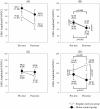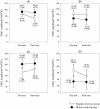Motor control integrated into muscle strengthening exercises has more effects on scapular muscle activities and joint range of motion before initiation of radiotherapy in oral cancer survivors with neck dissection: A randomized controlled trial
- PMID: 32760097
- PMCID: PMC7410307
- DOI: 10.1371/journal.pone.0237133
Motor control integrated into muscle strengthening exercises has more effects on scapular muscle activities and joint range of motion before initiation of radiotherapy in oral cancer survivors with neck dissection: A randomized controlled trial
Abstract
Background: Accessory nerve shoulder dysfunction is common after neck dissection in oral cancer survivors. This study aimed to investigate the short-term effects of scapular muscle strengthening exercises with motor-control techniques on neck dissection-related shoulder dysfunction in oral cancer survivors before the initiation of radiotherapy.
Methods: Thirty-eight participants were randomly allocated into the motor-control and regular-exercise groups. Each group received conventional physical therapy and specific scapular muscle strengthening exercises for 1 month immediately after neck dissection. Motor control techniques were integrated with scapular strengthening exercises for the motor-control group. Shoulder pain, active range of motion (AROM) of shoulder abduction, and scapular muscle activities including upper trapezius (UT), middle trapezius (MT), lower trapezius (LT), and serratus anterior (SA) when performing maximal voluntary isometric contraction (MVIC) and scapular muscle exercises were evaluated at baseline and after 1 month of training.
Results: Both groups reduced shoulder pain and increased muscle activity of maximum voluntary isometric contraction (MVIC) of each muscle after the intervention. Increased AROM of shoulder abduction was only observed in the motor-control group (95% CI 3.80 to 20.51, p = 0.004). Relative to baseline evaluation, muscle activities of UT decreased in the motor-control group when performing shoulder shrug with 1-kg weight (95% CI -33.06 to -1.29, p = 0.034). Moreover, the SA activity decreased in the motor-control group (95% CI -29.73 to -27.68, p<0.001) but increased in the regular-exercise group (95% CI 28.16 to 30.05, p<0.001) when performing shoulder horizontal adduction and flexion.
Conclusion: Early strengthening exercise with motor control techniques has greater benefits for improving AROM of shoulder abduction, muscle economy, and reducing compensatory scapular muscle activities in patients with neck dissection-related shoulder dysfunction before the initiation of radiotherapy.
Conflict of interest statement
The authors have declared that no competing interests exist.
Figures





Similar articles
-
A randomized controlled trial of scapular exercises with electromyography biofeedback in oral cancer patients with accessory nerve dysfunction.Support Care Cancer. 2022 Oct;30(10):8241-8250. doi: 10.1007/s00520-022-07263-4. Epub 2022 Jul 11. Support Care Cancer. 2022. PMID: 35821447 Clinical Trial.
-
Effects of Conscious Control of Scapular Orientation in Oral Cancer Survivors With Scapular Dyskinesis: A Randomized Controlled Trial.Integr Cancer Ther. 2021 Jan-Dec;20:15347354211040827. doi: 10.1177/15347354211040827. Integr Cancer Ther. 2021. PMID: 34412536 Free PMC article. Clinical Trial.
-
Conscious correction of scapular orientation in overhead athletes performing selected shoulder rehabilitation exercises: the effect on trapezius muscle activation measured by surface electromyography.J Orthop Sports Phys Ther. 2013 Jan;43(1):3-10. doi: 10.2519/jospt.2013.4283. Epub 2012 Nov 16. J Orthop Sports Phys Ther. 2013. PMID: 23160271
-
Optimal activation ratio of the scapular muscles in closed kinetic chain shoulder exercises: A systematic review.J Back Musculoskelet Rehabil. 2021;34(1):3-16. doi: 10.3233/BMR-191771. J Back Musculoskelet Rehabil. 2021. PMID: 32831190
-
Muscle Activity Ratios of Scapular Stabilizers During Closed Kinetic Chain Exercises in Healthy Shoulders: A Systematic Review.J Sport Rehabil. 2019 Dec 19;29(7):1001-1018. doi: 10.1123/jsr.2018-0449. Print 2020 Sep 1. J Sport Rehabil. 2019. PMID: 31860828
Cited by
-
Strength Training versus Stretching for Improving Range of Motion: A Systematic Review and Meta-Analysis.Healthcare (Basel). 2021 Apr 7;9(4):427. doi: 10.3390/healthcare9040427. Healthcare (Basel). 2021. PMID: 33917036 Free PMC article. Review.
-
A randomized controlled trial of scapular exercises with electromyography biofeedback in oral cancer patients with accessory nerve dysfunction.Support Care Cancer. 2022 Oct;30(10):8241-8250. doi: 10.1007/s00520-022-07263-4. Epub 2022 Jul 11. Support Care Cancer. 2022. PMID: 35821447 Clinical Trial.
-
State of Rehabilitation Research in the Head and Neck Cancer Population: Functional Impact vs. Impairment-Focused Outcomes.Curr Oncol Rep. 2022 Apr;24(4):517-532. doi: 10.1007/s11912-022-01227-x. Epub 2022 Feb 19. Curr Oncol Rep. 2022. PMID: 35182293 Review.
-
Effects of Conscious Control of Scapular Orientation in Oral Cancer Survivors With Scapular Dyskinesis: A Randomized Controlled Trial.Integr Cancer Ther. 2021 Jan-Dec;20:15347354211040827. doi: 10.1177/15347354211040827. Integr Cancer Ther. 2021. PMID: 34412536 Free PMC article. Clinical Trial.
-
Importance of Cardiac Rehabilitation and Mouth Opening Exercises in Oral Squamous Cell Carcinoma: A Case Report.Cureus. 2023 Dec 22;15(12):e50954. doi: 10.7759/cureus.50954. eCollection 2023 Dec. Cureus. 2023. PMID: 38249192 Free PMC article.
References
-
- Ewing MR, Martin H. Disability following radical neck dissection; an assessment based on the postoperative evaluation of 100 patients. Cancer. 1952;5(5):873–83. - PubMed
-
- Erisen L, Basel B, Irdesel J, Zarifoglu M, Coskun H, Basut O, et al. Shoulder function after accessory nerve-sparing neck dissections. Head & neck. 2004;26(11):967–71. - PubMed
-
- Carr SD, Bowyer D, Cox G. Upper limb dysfunction following selective neck dissection: a retrospective questionnaire study. Head & neck. 2009;31(6):789–92. - PubMed
-
- Dijkstra PU, van Wilgen PC, Buijs RP, Brendeke W, de Goede CJ, Kerst A, et al. Incidence of shoulder pain after neck dissection: a clinical explorative study for risk factors. Head & neck. 2001;23(11):947–53. - PubMed
Publication types
MeSH terms
LinkOut - more resources
Full Text Sources
Medical

